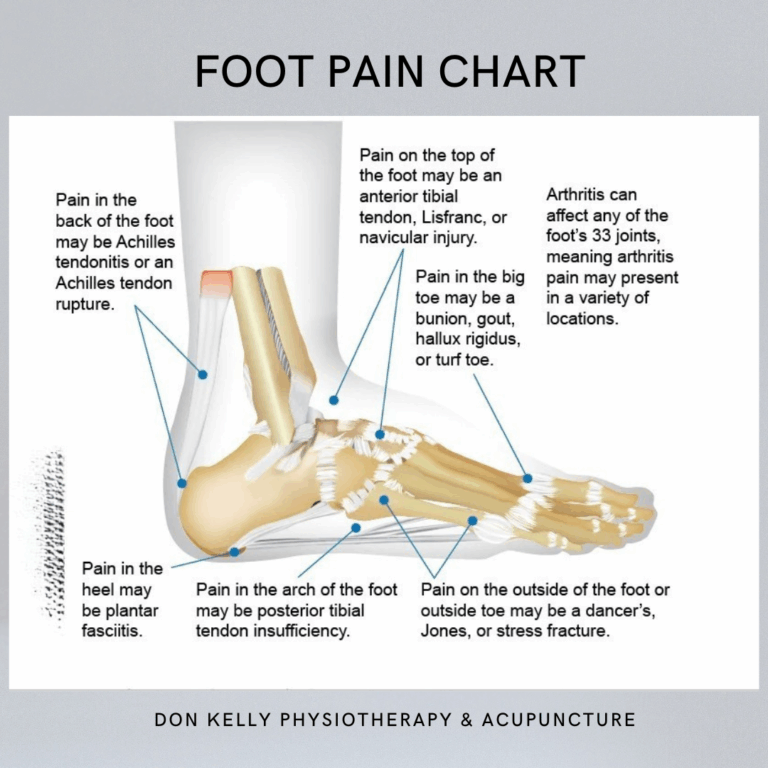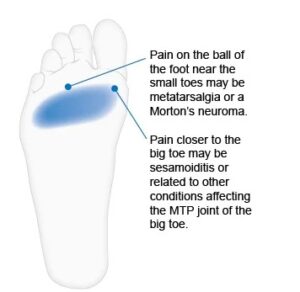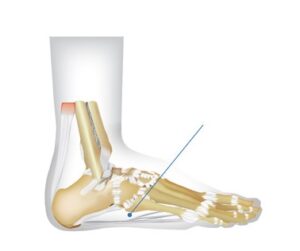If you’re based in Limerick or Charleville and struggling with persistent foot or ankle pain, this article is for you. At Don Kelly Physiotherapy & Acupuncture, we understand how foot pain can undermine your mobility, your day-to-day comfort, and your lifestyle. Here’s how we help — and how you can take the first step toward relief.
Why foot pain matters — and what might be causing yours
Your feet are remarkable structures — 26 bones, 33 joints, over 100 muscles, tendons and ligaments all working in coordination every time you walk, run or stand.
That complexity is both a strength and a source of vulnerability: when something goes wrong, pain can manifest in many ways.
Foot Pain Chart

Foot pain should prompt attention especially if it lingers, worsens or limits weight-bearing activity.
Here are key locations and what they often reflect:
Top of Foot Pain
- Pain at the top of the foot near the ankle may be due to a stress fracture of the navicular bone. This is caused by repetitive force and is more commonly seen in athletes like basketball players and gymnasts.
- Pain at the top of the foot after an injury to the foot may be a Lisfranc injury, which is disruption of a strong ligament in the middle of the foot that holds up the arch.
- Pain at the top of the middle of the foot can be caused by arthritis in the small bones of the midfoot. Arthritis is the loss of cartilage in a joint and is typically due to wear and tear over time. The pain may be exacerbated when tying shoes too tightly.
- Similar to midfoot arthritis, pain on the top of the midfoot may be due to tendonitis of the anterior tibial tendon. This is typically an overuse injury of the tendon that helps you dorsiflex (bring the foot up off the ground).
Back of the foot pain – Achilles tendon conditions
Achilles tendon conditions include:
- Achilles tendonitis is inflammation to the Achilles tendon that links your calf muscles to your heel bone.
- Achilles tendon ruptures are tears of the Achilles tendon and often associated with a “pop” in the back of the ankle felt during physical activity.
Bottom of foot pain

Conditions causing pain at the bottom can be categorized, generally, by whether the pain resides in the ball (forefoot), arch (midfoot), or heel (hindfoot).
Pain in the ball of the foot
Pain in the ball of your foot can stem from any one of these conditions:
- Sesamoiditis is inflammation of the small bones shaped like sesame seeds located beneath the big toe joint.
- Arthritis in one or more MTP joints can also lead to stiffness and pain in the ball of the foot.
- Morton’s neuroma is a benign growth of nerve tissue usually located between the third and fourth metatarsal heads, can cause pain in the ball of the foot.
- Metatarsalgia is a broad term that refers to pain under the metatarsophalangeal (MTP) joints (where the metatarsal bones meet the phalanges or toe bones), which can arise from various conditions.
- Bunions are bony bumps that form on the joint at the base of your big toe, sometimes cause pain in the ball of the foot as a result of the big toe’s poor alignment as increased force is transferred under the adjacent bones. This is a common cause of metatarsalgia.
Foot arch pain

Pain in the arch of the foot can be attributed to several conditions:
- Flatfoot, has many names and is also known as progressive collapsing foot deformity, adult acquired flatfoot deformity, posterior tibial tendon insufficiency, or “fallen arches,” is characterized by a shallow or absent arch on the inner side of the foot. The absence of the arch can cause increased stress on the foot’s structures including the bones, ligaments, and tendons, leading to pain in the arch and potentially other areas of the foot.
- Conditions in the forefoot or hindfoot can also sometimes lead to secondary symptoms in the arch. For example, Morton’s neuroma can result in a sensation similar to walking on a pebble, which may cause discomfort in the arch.
Heel pain
Heel pain is a common ailment that can be caused by several factors, often related to strain or injury.
- Plantar fasciitis, an inflammation of the plantar fascia – a band of tissue that runs across the bottom of your foot from your heel bone to the base of your toes. This condition can result from chronic trauma such as running in unsupportive shoes, or it may occur spontaneously without any clear reason. In some people, the specific biomechanics of their feet, such as high arches, may increase the likelihood of developing plantar fasciitis.
- Heel spurs do not usually cause pain in and of themselves but are often seen on X-rays and may be seen in conjunction with plantar fasciitis or Achilles tendon pain.
How Don Kelly can help you live pain-free again
In the Limerick and Charleville areas, our clinic offers tailored physiotherapy, acupuncture and dry-needling treatments designed to get at the root of your foot-and-ankle pain rather than just relieve symptoms.
Here’s our approach:
Comprehensive assessment: We don’t just look at your foot — we assess your whole kinetic chain (how your foot, ankle, knee, hip and spine interact). This holistic view helps identify contributing factors like gait dysfunction, alignment issues or muscle imbalances.
Targeted treatment plan: Depending on your diagnosis (for example, plantar fasciitis, stress fracture, Morton’s neuroma, tendonitis), we may incorporate:
Physiotherapy (manual therapy, stretching, strengthening, gait retraining)
Acupuncture or dry-needling to address myofascial (muscle and connective tissue) trigger points and aid healing
Custom orthotics advice or footwear assessment
Rehabilitation exercises you can do at home
Load-management and advice on activity modification
Prevention & optimisation: We help you identify why the issue occurred (e.g., repetitive strain from standing work, unsupportive shoes, altered foot mechanics) and give you tools to prevent recurrence.
Support for all ages and activity levels: Whether you’re a desk-worker in Limerick city, a recreational athlete in Charleville, or someone whose job involves standing or walking long hours — you can benefit.


